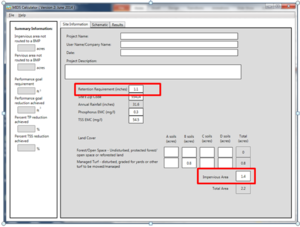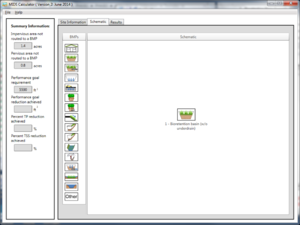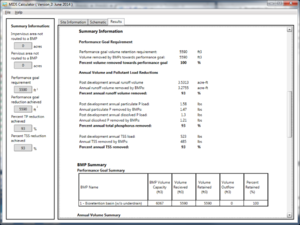
Difference between revisions of "MIDS calculator"
m |
m |
||
| Line 35: | Line 35: | ||
The annual stormwater runoff volume, pollutant loads for TSS, dissolved phosphorus, and particulate phosphorus are calculated following the runoff reduction method developed by the Center for Watershed Protection & Chesapeake Stormwater Network (CWP & CSN, 2008), which is based off the Simple Method (Schueler, 1987). The runoff reduction method calculates the annual runoff stormwater volume (R) in cubic feet based on the following | The annual stormwater runoff volume, pollutant loads for TSS, dissolved phosphorus, and particulate phosphorus are calculated following the runoff reduction method developed by the Center for Watershed Protection & Chesapeake Stormwater Network (CWP & CSN, 2008), which is based off the Simple Method (Schueler, 1987). The runoff reduction method calculates the annual runoff stormwater volume (R) in cubic feet based on the following | ||
| − | <math> | + | <math>R = D_R * A * 3630</math> |
Where | Where | ||
Revision as of 19:34, 31 March 2015
Contents
Overview

A Minimal Impact Design Standards (MIDS) best management practice (BMP) calculator was developed to assist designers and regulators in determining conformance to the MIDS performance goals The MIDS BMP calculator is a tool used to determine stormwater runoff volume and pollutant reduction capabilities of various low impact development (LID) BMPs. The MIDS calculator estimates the stormwater runoff volume reductions for various BMPs based on the MIDS performance goal (1.1 inches of runoff off impervious surfaces) and annual pollutant load reductions for total phosphorus (including a breakdown between particulate and dissolved phosphorus) and total suspended solids (TSS).
The MIDS calculator is designed in Microsoft Excel with a graphical user interface (GUI), packaged as a windows application, used to organize input parameters. The Excel spreadsheet conducts the calculations and stores parameters, while the GUI provides a platform that allows the user to enter data and presents results in a user-friendly manner.
The MIDS calculator is divided into four main components: the “Site information” tab, “Schematic” tab, “BMP Properties” window, and “Results” tab. The “Site information” tab is where the user enters information for the entire site being studied. This includes information used to calculate annual precipitation for the study area, average pollutant concentrations in runoff from the entire site, as well as land used areas for the entire study area. The “Schematic” tab is where the user adds or removes BMPs to the site and provides a visual diagram of all BMPs and routing between BMPs. In the “BMP Properties” window the user enters land use areas, routing information, and design parameters specific to an individual BMP. Finally, in the “Results” tab, results are displayed for the entire site as well as individual BMPs. Results include pollutant removal rates and loads, annual volume reduction, as well as conformance to the MIDS performance goal. A detailed overview of individual input parameters and workflows is presented in the MIDS Calculator User Documentation. Below is a detailed discussion of the main objectives of the MIDS calculator and the calculations that take place to meet those objectives.
Objectives
The calculator has five main objectives:
- Calculates the stormwater runoff volume reduction performance goal for a site.
- Calculates annual stormwater runoff volumes and pollutant loads (total suspended sediment, dissolved phosphorus, and particulate phosphorus) from site.
- Provides a method to add stormwater BMPs, input BMP specific parameters, and route overflow stormwater and pollutants to downstream practices.
- Calculate stormwater runoff volume reduction achieved toward the performance goal and annual stormwater volume and pollutant load reductions for each individual BMP and the entire site.
- Report results, including stormwater runoff volume reduction applied toward the performance goal, annual pollutant load reductions for TSS, dissolved phosphorus, and particulate phosphorus, as well as annual stormwater volume reduction for the entire site and individual BMPs.
Calculate Volume Reduction Performance Goal
The first objective of the MIDS calculator is to determine the stormwater runoff volume reduction performance goal requirement for a site. Through the implementation of the MIDS statute, the MIDS runoff volume performance goal was created: “For new, nonlinear developments that create more than one acre of new impervious surface on sites without restrictions, stormwater runoff volumes will be controlled and the post-construction runoff volume shall be retained on site for 1.1 inches of runoff from impervious surfaces statewide.” This goal is not time dependent but rather instantaneous. This means that a BMP must retain the required stormwater runoff volume whether it occurs in half an hour or over 12 hours.
For sites with restrictions, the MIDS Work Group recommended a flexible treatment option performance goal. Depending on the feasibility and prudence of implementing BMPs on a site, the flexible treatment option performance goal includes retaining on site at least 0.55 inches of runoff from impervious surfaces and removal of 75% of the annual total phosphorus load leaving the site. Less runoff volume and less total phosphorus load reduction is recommended for sites where implementing BMPs is not feasible or prudent. Off-site stormwater treatment is also allowed.
In the MIDs calculator, the performance goal requirement is calculated by multiplying the “Volume Retention Requirement” by the impervious area of the site. The default value for the volume retention requirement is 1.1 inches. This value can be changed in the calculator to reflect the flexible treatment option. For example, if flexible treatment options are needed for the site, the stormwater volume retention requirement can be changed to 0.55 inches. If changed from the default value of 1.1 inches, the MIDS calculator warns the user. The performance goal requirement is calculated in cubic feet.
The performance goal is calculated for the entire site using the land use parameters entered in the “Site Information” tab as well as for each individual BMP using the impervious area entered for that BMP in the BMP parameters window “Watershed” tab. This allows the user the track how he or she is meeting the performance goal for the entire site in addition to each individual BMP. A screen shot of the “Site Information” tab with the “Volume retention Requirement” and site “Impervious area” fields used in the volume reduction performance goal calculation highlighted is displayed below.
Calculate runoff annual volume and pollutant loads
The second objective of the MIDS calculator is to calculate annual stormwater runoff volume and pollutant loads for the site using the watershed information and pollutant event mean concentrations (EMCs) entered in the “Site Information” tab.
The annual stormwater runoff volume, pollutant loads for TSS, dissolved phosphorus, and particulate phosphorus are calculated following the runoff reduction method developed by the Center for Watershed Protection & Chesapeake Stormwater Network (CWP & CSN, 2008), which is based off the Simple Method (Schueler, 1987). The runoff reduction method calculates the annual runoff stormwater volume (R) in cubic feet based on the following
\(R = D_R * A * 3630\)
Where
- Dr is the annual runoff depth in inches;
- A is the total watershed area in acres; and
- 3630 is a conversion factor of to convert the final result to cubic feet.
The total watershed area (A) is an input parameter supplied by the user. The annual runoff depth Dr, is calculated using the following
\(D_r = P * P_j * R_v\)
Where:
- P is the total annual rainfall depth in inches;
- Pj is the fraction of annual rainfall events that product runoff; and
- RV is the runoff coefficient which is dimensionless.
The total annual rainfall depth (P) is determined based on zip code for the state of Minnesota. Average annual precipitation data was calculated using the normal annual precipitation data from the Minnesota Climatology Working Group (years 1971 – 2000) and spatially averaging for all zip codes in the state of Minnesota. The fraction of annual rainfall events that produce runoff (Pj) is set at a constant value of 0.9 as recommended by the runoff reduction method (CWP & CSN, 2008). The runoff coefficient (RV) is calculated based on the land use data. The user of the MIDS calculator enters land use information using three land use types and four soils types. The three land use types in the calculator are as follows (CWP & CSN, 2008).
- Impervious cover: A surface that prevents the infiltration of rainfall and results in an increased volume of surface runoff. This includes roadways, driveways, rooftops, parking lots, sidewalks, and other areas that replace an otherwise pervious surface. A green roof and permeable pavement should be entered as impervious surface.
- Managed turf: The disturbed area, graded for yards or other turf to be mowed/managed. This includes any turf areas that are intended to be mowed and maintained as turf within residential, commercial, industrial, institutional settings, and road right-of ways. BMP surface areas should also be included in this classification except for green roofs, permeable pavement constructed wetlands, and constructed stormwater ponds.
- Forest/open space: The undisturbed area, protected/open space or reforested land. This includes any forested or open space area protected during construction and that will remain undisturbed or will not be routinely mowed, but instead left in a natural vegetative state.
- Note: Water surface areas for wetlands and stormwater ponds should not be included as a landcover in the calculator. The calculator uses the conservative assumption that precipitation and evapotranspiration at the surface of these systems are neutralizing and that pollutant load additions from precipitation alone are minimal.
Each land use with an associated soil type is assigned a corresponding runoff coefficient (CWP & CSN, 2008). The corresponding runoff coefficients are displayed in the following table. An average runoff coefficient based on land use areas is calculated for the site and used to calculate the runoff depth.
This table shows runoff coefficients by land use and soil type.
Link to this table
| RV coefficients | A soils | B soils | C soils | D soils |
|---|---|---|---|---|
| Forest/Open space | 0.02 | 0.03 | 0.04 | 0.05 |
| Managed turf (disturbed soils) | 0.15 | 0.20 | 0.22 | 0.25 |
| Impervious cover | 0.95 | 0.95 | 0.95 | 0.95 |
The annual runoff volume is used to calculate the pollutant loads from the site. The pollutants loads (L) in pounds are calculated with the following
\(L = R * C * 6.243 * 10^-5\)
Where
- R is the annual runoff volume in cubic feet;
- C is an average annual pollutant concentration in mg/l; and
- 6.243 * 10-5 is a conversion factor of to convert the final result to pounds
The pollutant concentrations (C) for TSS and TP are input parameters in the “Site Information” tab with recommended values of 54.5 mg/l for the TSS EMC (Lin, 2003) and 0.3 mg/l (average concentrations for residential and multi-family residential areas reported by Pitt et al. 2004) for the total phosphorus EMC. These values represent the annual average pollutant concentration in the runoff stormwater from the site. Pollutant EMC values can be changed; however, data and analysis are required to support the new values.
The total phosphorus EMC is further divided into dissolved and particulate phosphorus. An analysis of nationwide stormwater monitoring data determined that the average percentage of dissolved phosphorus to total phosphorus is ~45% (Pitt et al., 2005). This division of total phosphorus to 45% dissolved and 55% particulate phosphorus was used to separate the total phosphorus EMC into dissolved and particulate constituents. Dividing the default total phosphorus EMC into dissolved and particulate phosphorus, results in concentrations of 0.135 mg/l for dissolved phosphorus and 0.165 mg/l for particulate phosphorus.
Annual runoff volumes and pollutant loads are calculated for the entire site using information entered in the “Site Information” tab, as well as for each individual BMP using the land use parameters entered for that BMP in the “BMP Properties” window. A screen shot of the “Site Information” tab with the fields used in the annual volume and pollutant load calculations highlighted is displayed below.
Add stormwater BMPs and calculator volume and pollutant reductions
A third objective of the MIDS calculator is to provide a method to add stormwater BMPs, input BMP specific parameters, and route overflow stormwater and pollutants to downstream practices. BMPs are added to the calculator in the “Schematic” tab by dragging and dropping the icons into the “Schematic” window. The calculator has a total of 13 BMPs that the user can select from and allows for the addition of up to 10 BMPs of a single type. Each BMP has specific design parameters used to calculate the reduction provided by the BMP towards the performance goal as well as the annual volume and pollutant load reductions.
The fourth objective is to calculator the volume and pollutant reductions for each individual BMP added to the calculator. The BMPs in the calculator are listed below. Links are provided to pages specific to that BMP detailing the design parameters needed in the calculator and the individual methods used to calculator volume reductions applied towards meeting the performance goal as well as annual volume and pollutant load reductions.
Pollutant removal rates are calculator for each individual BMP and for each pollutant (TSS, dissolved phosphorus and particulate phosphorus). The percent annual total pollutant removal rate (PRtot) is calculated using the following
\(PR_{tot}= (RVR * PR_{Ret}) + ((100 - RVR) * PR_{over})\)
Where:
- RVR is the percent annual runoff volume retained;
- PRretis the percent annual pollutant removal rate applied to the annual water volume retained
- (RVR) by the BMP; and
- PRover is the percent annual pollutant removal rate applied to the annual water volume routed downstream.
The values used in the above calculation are defined for each BMP in the BMP specific links above.
Report Results
The final objective of the calculator is to report results to the users. Results are reported in the “Results” tab for the entire site as well as by individual BMPs. The results tab summarizes the volume and pollutant reduction results based on the BMP alignment and design parameters. There are five main sections of the results section: Project Information, Site Information, Summary Information, BMP Summary, and BMP Schematic. The Summary Information section of the Results tab summarizes both the performance goal requirement as well as the annual volume and pollutant load reductions achieved by the modeled system. All five parameters (volume towards the performance goal, annual volume, dissolved P, particulate P, and TSS) are reported in terms of the amount (volume or load) created by the entire site, the amount removed by the BMPs added to the site and finally a percent removal for the entire site. The BMP summary sections details volume and pollutant load reductions for each individual BMP.
References
- Center for Watershed Protection & Chesapeake Stormwater Network (CWP & CSN), 2008. Technical Memorandum: The Runoff Reduction Method. April
- Lin, J.P.: Review of Published Export Coefficient and Event Mean Concentration (EMC) Data. Wetlands Regulatory Assistance Program ERDC TN-WRAP-04-3 (September 2004)
- Pitt, R., A. Maestre, R. Morquecho, T. Brown, T. Schueler, K. Cappiella and P. Sturm, 2005. Evaluation of NPDES Phase 1 Municipal Stormwater Monitoring Data. University of Alabama and the Center for Watershed Protection.
- Schueler, T. 1987. Controlling Urban Runoff: A Practical Manual for Planning and Designing Urban Best Management Practices. MWCOG. Washington, D.C
- Calculator - link to the MIDS calculator
- User’s Guide
- Links to Manual pages that address the MIDS calculator
- MIDS calculator sample exercises
- MIDS technical documents - documents prepared during development of the calculator
- Technical documents - these are final work products developed by Barr Engineering during the MIDS Project. Most are specific to an individual BMP.
- Links to other calculators
- Requirements, recommendations and information for using Other as a BMP in the MIDS calculator
- Conversion units - list of conversion units that may be used with the MIDS calculator
List of Super Users
The MPCA trained over 50 people across the state to become “Super Users” of the MIDS Calculator. People on the list have agreed to help others use the calculator. Feel free to contact them if you have a question on how to use the calculator.


